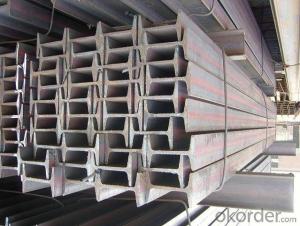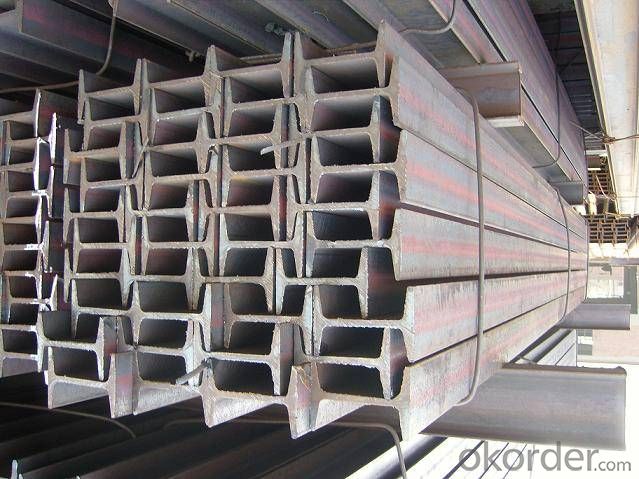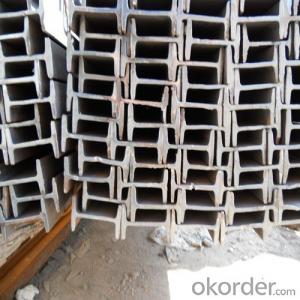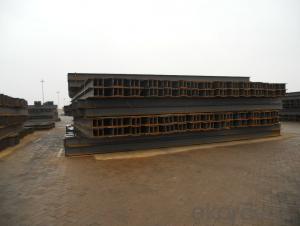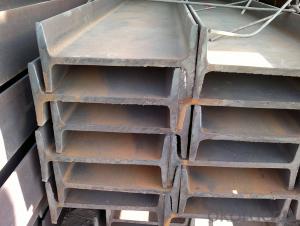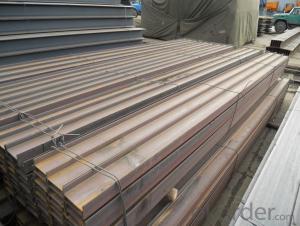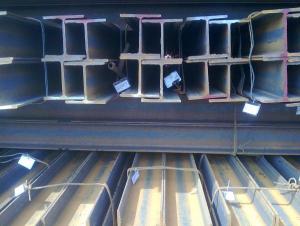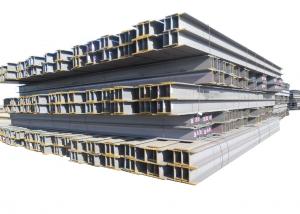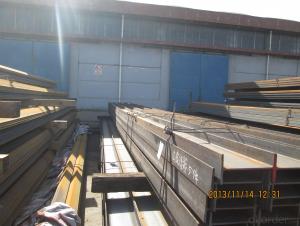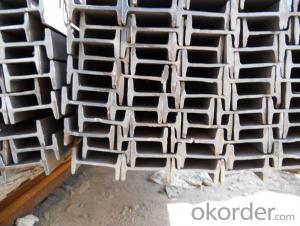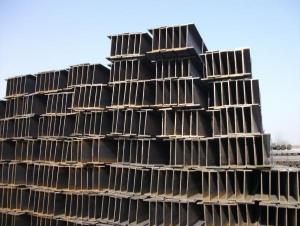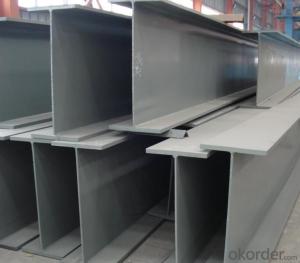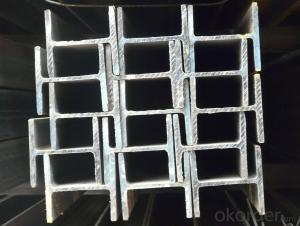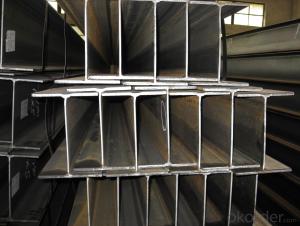175*90mm hot sell h beam for construction
- Loading Port:
- Tianjin
- Payment Terms:
- TT or LC
- Min Order Qty:
- 25 m.t.
- Supply Capability:
- 100000 m.t./month
OKorder Service Pledge
OKorder Financial Service
You Might Also Like
Secifications of Hot Rolled Steel H-beam
1. Standard: JIS 3192
2. Grade: SS400 or Equivalent
3. Length: 10m, 12m as following table
4. Invoicing on theoretical weight or actual weight as customer request
5.Payment: TT or L/C
Packaging & Delivery of Hot Rolled H-Beam Steel for Building Structures
1. Packing: it is nude packed in bundles by steel wire rod
2. Bundle weight: not more than 3.5MT for bulk vessel; less than 3 MT for container load
3. Marks:
Color marking: There will be color marking on both end of the bundle for the cargo delivered by bulk vessel. That makes it easily to distinguish at the destination port.
Tag mark: there will be tag mark tied up on the bundles. The information usually including supplier logo and name, product name, made in China, shipping marks and other information request by the customer.
If loading by container the marking is not needed, but we will prepare it as customer request.
4. Transportation: the goods are delivered by truck from mill to loading port, the maximum quantity can be loaded is around 40MTs by each truck. If the order quantity cannot reach the full truck loaded, the transportation cost per ton will be little higher than full load.
5. Delivered by container or bulk vessel
* If you would like to get our price, please inform us the size, standard/material and quantity. Thank you very much for your attention
Function Structure
Light H-beam has been widely applied as building material and has a very good market prospect. High frequency H-beam welding is a new technology for H-beam welding with the advantages of energy-saving, high efficiency and convenient operation etc.
H-beam welding equipment adopts two sets 300kW or 600kW solid state high frequency welder with exactly the same model. One welds web plate and upper flange plate, the other welds web plate and lower flange plate. The welding mode is contact welding. Solid state high frequency welder adopts AC-DC-AC frequency conversion structure. The rectifier adopts 3-phase thyristor. The inverter adopts high voltage large power MOSFET to form full bridge resonance inversion. Inverter output adopts high efficiency ferrite matching transformer to finish power combination, impedance matching and electrical isolation. Resonance tank circuit adopts two sides serial resonance.
The complete unit of equipment is composed of switchgear rectifying cabinet, inverter output cabinet, contact head mechanism, circulation soft water cooling system, console and 3-D positioning table.
Technical Features
Ø Perfect structure design
1.Independent design of switchgear rectifying cabinet and inverter output cabinet, connected by soft cable, which is convenient for layout at user’s site.
2.Power combination of the inverter bridge is accomplished by the way of power unit superposition. Each MOSFET power unit is designed to be 100kW and slideway drawer structure, which is convenient for installation and repair.
3.3-D positioning table is adopted for both of the two sets contact type welder. Contact head adopts pressure control, which has a good synchronism and consistency.
4.High standard electromagnetism compatibility design, electromagnetism radiation meets national standard.
5.Closed cabinet design, meeting rigor environmental requirements on site.
Ø Full-digital Synchronization Control System
1. 3-phase rectifier adopts high cost performance MCU controlling to realize precise synchronism trigger with high control precision and small grid-side non characteristic harmonic.
2. Resonant inverter adopts CPLD to form full-digital control system that is characterized by their automatic constant angle, high phase-lock precise and wide scope of phase-lock.
3. The two sets solid state high frequency welder has the function of synchronization control with the features of stable working and small interference.
4.The welder has perfect protection function with reliable working and low failure rate.
Ø HMI and fault diagnosis system
1. Adopt PLC and touch screen to form perfect HMI system.
2. Realize integrated automatic control of welder system.
3. Fault display and diagnosis system.
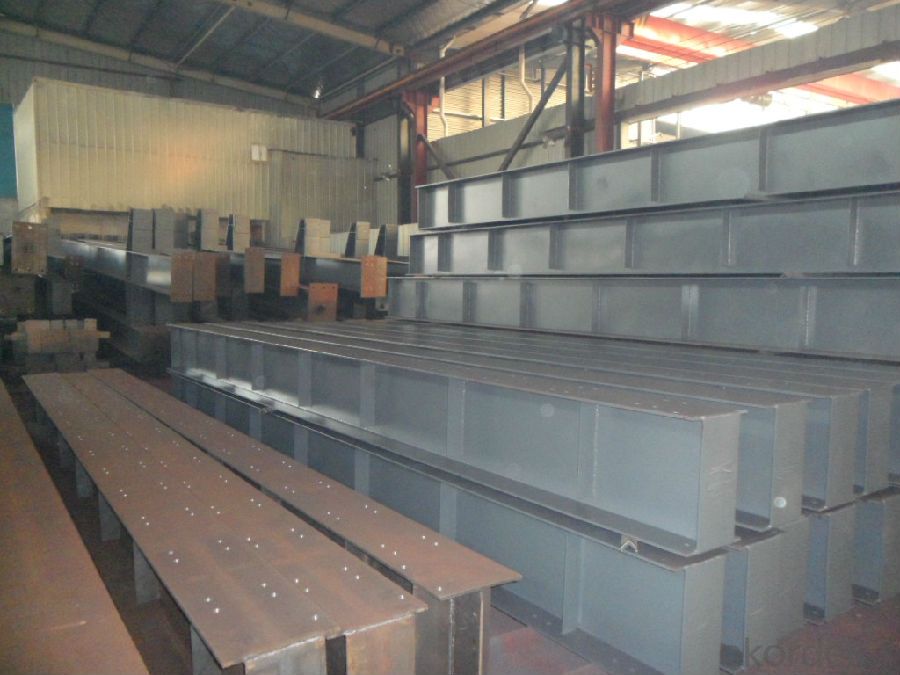
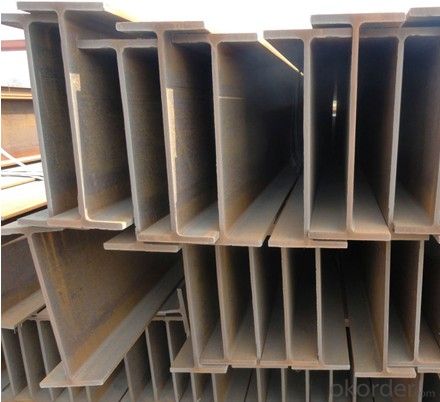
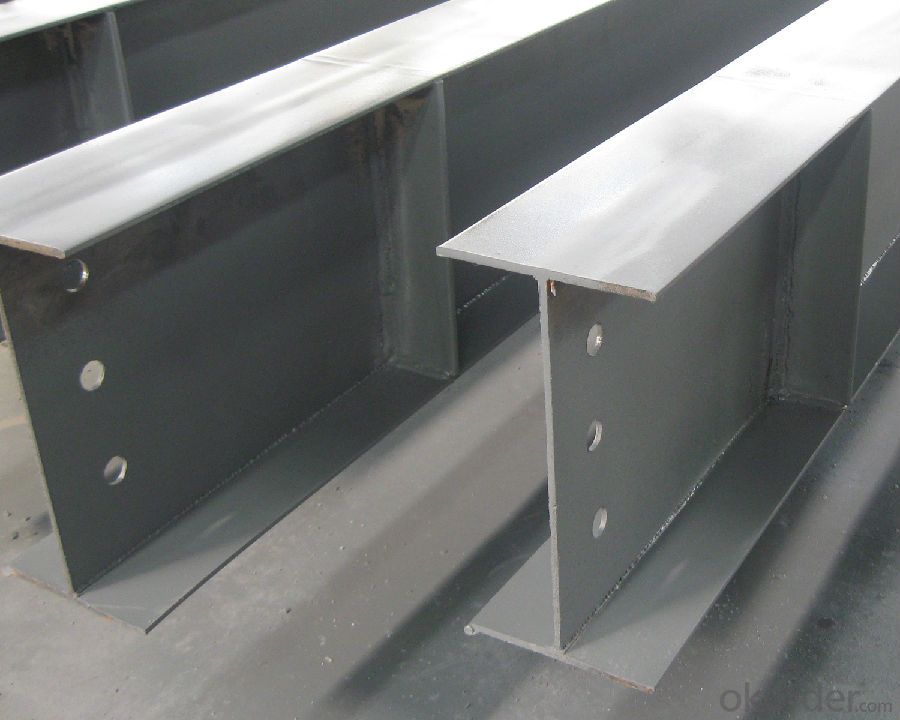
- Q: What are the considerations when designing for natural disaster planning in Steel H-Beams?
- When designing for natural disaster planning in Steel H-Beams, there are several considerations to keep in mind. Firstly, it is crucial to understand the specific requirements and regulations set by local building codes and standards for structural resilience against natural disasters such as earthquakes, hurricanes, or floods. These codes often include guidelines for material strength, connections, and overall structural stability. Additionally, the design should account for the potential impact of extreme environmental conditions on the steel beams, such as high winds, heavy rain, or seismic forces. Engineers should consider factors like load-bearing capacity, deflection, and buckling resistance to ensure the beams can withstand the expected forces and remain intact during a natural disaster. Furthermore, proper connections and detailing of the steel H-beams are vital to ensure the overall structural integrity. The design should incorporate appropriate joint connections, such as welding or bolted connections, to ensure that the beams can effectively transfer forces and resist any sudden movements or displacements caused by the disaster. Lastly, regular inspections, maintenance, and repairs should be included in the design considerations. These measures help to ensure the ongoing safety and reliability of the steel H-beams, as any damage or deterioration can compromise their performance during future natural disasters. In summary, when designing for natural disaster planning in Steel H-Beams, it is essential to adhere to local building codes, consider the impact of extreme environmental conditions, incorporate proper connections and detailing, and prioritize ongoing maintenance and inspections.
- Q: Can steel H-beams be used in airport hangar or aircraft maintenance facilities?
- Yes, steel H-beams can be used in airport hangars or aircraft maintenance facilities. Steel H-beams are versatile structural elements that offer excellent strength-to-weight ratio and load-bearing capabilities. They are commonly used in construction projects that require large open spaces, such as aircraft hangars and maintenance facilities. The H-shaped design of the beams provides structural rigidity and stability, making them suitable for supporting heavy loads and withstanding the dynamic forces associated with aircraft operations. Additionally, steel H-beams can be easily fabricated and installed, allowing for efficient construction and customization to meet specific design requirements. Overall, steel H-beams are a popular choice in the aviation industry due to their strength, durability, and versatility.
- Q: How do steel H-beams contribute to the overall stability of a building?
- Steel H-beams contribute to the overall stability of a building in several ways. Firstly, H-beams are designed to support heavy loads and resist bending, making them suitable for structural applications. The shape of the H-beam provides a high strength-to-weight ratio, allowing it to efficiently distribute and transfer the load from the roof, walls, and floors to the foundation. This ensures that the building can withstand the forces it is subjected to, such as gravity, wind, and seismic loads. Additionally, the use of steel H-beams allows for the creation of long spans, which eliminates the need for excessive columns or supports within the building. This not only provides more open and flexible floor plans but also reduces construction costs and maximizes usable space. The ability to have larger open areas without compromising structural integrity enhances the overall stability of the building. Moreover, steel H-beams offer exceptional resistance to fire, which is crucial for the safety of the occupants and the protection of the building itself. Steel has a high melting point, meaning it can withstand extreme temperatures for longer periods compared to other building materials. This fire resistance provides additional time for evacuation and emergency response, minimizing the risk of structural collapse during a fire. Furthermore, steel H-beams are highly durable and resistant to corrosion, ensuring the longevity of the building's structural framework. Steel is not susceptible to rot, pests, or moisture damage, which can compromise the stability of other materials like wood. The long-term durability of steel H-beams guarantees that the building remains stable and secure over its intended lifespan. In conclusion, steel H-beams contribute significantly to the overall stability of a building by providing strong structural support, allowing for long spans and open floor plans, offering fire resistance, and ensuring durability. The use of steel H-beams enhances the safety, functionality, and longevity of the building, making it an essential component in modern construction.
- Q: What are the different design considerations when using steel H-beams in architectural projects?
- When using steel H-beams in architectural projects, there are several important design considerations to take into account. Firstly, the structural requirements of the project must be carefully assessed to determine the appropriate size and strength of the H-beams. This involves considering factors such as the loads the beams will need to support, the span they will cover, and any potential deflection limits. Another consideration is the aesthetic aspect of the design. Steel H-beams can be left exposed as a design feature in some architectural projects, so the appearance and finish of the beams should be considered. This may involve selecting a specific type of steel with desired aesthetics or exploring options for coatings or finishes. Fire resistance is also a crucial consideration. Steel H-beams can lose their strength in high temperatures, so fire protection measures need to be incorporated into the design. This may involve using fire-resistant coatings or incorporating fire-rated materials to protect the beams. Lastly, the fabrication and installation process should be considered. Steel H-beams are typically fabricated off-site and then transported to the construction site. Therefore, transportation and lifting requirements, as well as the ease of on-site assembly, must be taken into account during the design process. Overall, careful consideration of structural, aesthetic, fire resistance, and fabrication considerations is essential when using steel H-beams in architectural projects.
- Q: Can steel H-beams be used in the construction of railway bridges?
- Indeed, railway bridges can utilize steel H-beams for their construction. The reason behind the widespread use of steel H-beams in bridge construction is their remarkable strength-to-weight ratio. This advantageous characteristic enables longer spans and minimizes the required amount of materials. Moreover, steel H-beams possess excellent corrosion resistance, ensuring durability and a prolonged lifespan for the structure. Furthermore, the ease of fabrication and connection of steel H-beams make them a financially viable choice for constructing railway bridges.
- Q: Can steel H-beams be used in data center construction?
- Yes, steel H-beams can be used in data center construction. Steel H-beams provide excellent structural support and load-bearing capacity, making them suitable for constructing data centers that require robust and secure infrastructure.
- Q: How do steel H-beams contribute to indoor air quality in buildings?
- The role of steel H-beams in maintaining indoor air quality in buildings is minimal. H-beams, which are load-bearing structural elements, are typically constructed from steel. Steel is an inert material that does not release volatile organic compounds (VOCs) or harmful emissions. Unlike wood or certain types of plastics, steel H-beams do not emit pollutants or allergens into the indoor air. However, it is important to consider that indoor air quality is affected by various factors, including ventilation systems, building materials, furniture, and occupant activities. Steel H-beams indirectly contribute to a healthy indoor environment by providing a strong and long-lasting framework for the building, ensuring proper ventilation and efficient air circulation. Moreover, steel H-beams are commonly used in construction due to their fire-resistant properties. During a fire, steel does not release toxic gases or smoke that can harm indoor air quality. This enhances the safety of the building occupants and reduces the potential health risks associated with poor air quality during fire incidents. To conclude, although steel H-beams themselves do not have a direct impact on indoor air quality, their use promotes a healthier indoor environment through their non-emissive nature and fire-resistant characteristics. The overall indoor air quality is influenced by a combination of factors, and the utilization of steel H-beams aids in creating a safe and sustainable building structure that supports good air quality.
- Q: Can steel H-beams be used for overhead doors or openings?
- Steel H-beams are not typically utilized for overhead doors or openings. In construction projects, H-beams serve primarily as structural support for beams, columns, and building frames. They are engineered to withstand heavy loads and provide stability to structures. When it comes to overhead doors or openings, alternative materials and designs are generally preferred. Overhead doors are usually constructed using steel or aluminum panels, which are lighter and easier to operate. These panels are designed to be connected with hinges, enabling them to roll up into a coil or fold up overhead for opening. This design ensures smooth operation and efficient utilization of space. Using H-beams for overhead doors or openings would not be practical or efficient. Their weight and size would pose difficulties in operation, and their design does not suit roll-up or folding mechanisms. Moreover, H-beams are primarily intended for load-bearing purposes, so utilizing them for openings could compromise the structural integrity of the building. Therefore, it is advisable to utilize appropriate materials and designs that are specifically engineered for overhead doors or openings, rather than steel H-beams.
- Q: What is the height of the four fillet welds in H steel submerged arc welding, such as H600*300*6*12?
- If the two plate welding, plate thickness is 12, the value is 0.7 and the thickness (refer to the design of a request) if there is important structures such as crane beam (refer to the design without the requirement of weld size) as above, but must use full penetration welding
- Q: How do Steel H-Beams perform in seismic or high-wind conditions?
- Both seismic and high-wind conditions are situations where Steel H-Beams excel. These beams are specifically designed to endure the forces exerted during earthquakes and strong winds, making them the preferred option for structural applications in areas that are susceptible to such events. In seismic conditions, Steel H-Beams are highly effective due to their inherent strength and flexibility. Their H-shape design enhances their resistance against lateral forces, allowing them to distribute and dissipate the energy produced by earthquake vibrations. This minimizes damage to the overall structure and enhances the safety of the building and its occupants. Similarly, Steel H-Beams perform exceptionally well in high-wind conditions. Their structural properties, such as their high strength-to-weight ratio and rigidity, enable them to withstand strong wind loads. The H-Beams' shape efficiently transfers wind forces to the foundation, preventing excessive movement and ensuring structural stability. Furthermore, the performance of Steel H-Beams in seismic or high-wind conditions can be further improved through various methods. Reinforcing the beams with additional steel plates, using higher-grade steel, or implementing advanced connection details can all contribute to increased resilience and reliability. Overall, Steel H-Beams are a dependable choice for construction projects in areas prone to seismic or high-wind conditions. Their ability to withstand and dissipate forces generated by earthquakes or strong winds makes them an ideal structural element, guaranteeing the safety and durability of buildings in challenging environments.
Send your message to us
175*90mm hot sell h beam for construction
- Loading Port:
- Tianjin
- Payment Terms:
- TT or LC
- Min Order Qty:
- 25 m.t.
- Supply Capability:
- 100000 m.t./month
OKorder Service Pledge
OKorder Financial Service
Similar products
Hot products
Hot Searches
Related keywords
